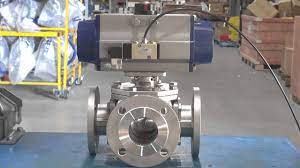
Air Actuated Ball Valves: Precision in Motion
As a homeowner or a professional within the plumbing industry, it is crucial to understand the functionality of valves for the effective control of water flow. A wide variety of valves are available in the market, each with its unique design and benefits. Among these valves is the ball valve, which has proven to be incredibly versatile, efficient, and durable in its application over the years. In this blog, we will be exploring ball valves, their applications, and the advantages of using them over other valves.
Ball valves are typically constructed with a lever handle, body, and a ball with a hole through the center that facilitates fluid flow. It is designed with precise engineering and consists of parts that work together to either turn the valve on or off. The ball inside the valve will typically have a hole that either allows or disallows fluid to flow through. Ball valves are characterized by their ability to provide a tight seal, which is enabled by the ball being pressed into the valve body by the force of the fluid pressure.
Air actuated ball valve are preferred over other valves due to their unique properties, one of which is their ability to provide precise control of the water flow. This precision control is enabled by the ball’s ability to rotate 90 degrees, which can either allow or disallow fluid flow. Additionally, these valves do not require lubricants, which reduces the risk of contamination of the fluid and enhances operational efficiency.
Another advantage of ball valves is their ease of operation with a simple quarter-turn of the lever handle. This ease of operation is ideal for irrigation and HVAC systems where frequent valve operation might be necessary. Additionally, ball valves are highly durable and resistant to pressure, heat, and corrosive materials. This durability is a significant advantage when they are used in industrial applications that require robust, long-lasting valves.
Ball valves come in different designs, including the two-way ball valve, three-way ball valve, four-way ball valve, and the multi-port ball valve. The two-way ball valve is the most common and consists of two ports that are used to control the flow of a single fluid. The three-way ball valve, on the other hand, can control two fluids and direct them to one outlet. Four-way ball valves are used to manage three fluids and direct them to one outlet; it is ideal for processes that require the combination of various fluids.
In short:
Ball valves have become an essential component in the plumbing industry, and mastering their control is crucial for the effective control of fluid flow in both domestic and industrial applications. From their ease of operation to their durability and precise control, ball valves have proven to be reliable and efficient in their application. We hope this blog has enlightened you on the advantages of ball valves and their applications. If you’re looking for a valve that guarantees precise control, high durability, and ease of operation, a ball valve might just be the best option for you.



